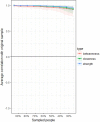Network analysis of the relationship between depressive symptoms, demographics, nutrition, quality of life and medical condition factors in the Osteoarthritis Initiative database cohort of elderly North-American adults with or at risk for osteoarthritis
- PMID: 30698512
- PMCID: PMC8061212
- DOI: 10.1017/S204579601800077X
Network analysis of the relationship between depressive symptoms, demographics, nutrition, quality of life and medical condition factors in the Osteoarthritis Initiative database cohort of elderly North-American adults with or at risk for osteoarthritis
Erratum in
-
Network analysis of the relationship between depressive symptoms, demographics, nutrition, quality of life and medical condition factors in the Osteoarthritis Initiative database cohort of elderly North-American adults with or at risk for osteoarthritis - CORRIGENDUM.Epidemiol Psychiatr Sci. 2019 Mar 8;29:e22. doi: 10.1017/S2045796019000064. Epidemiol Psychiatr Sci. 2019. PMID: 30846023 Free PMC article. No abstract available.
Abstract
Aims: A complex interaction exists between age, body mass index, medical conditions, polypharmacotherapy, smoking, alcohol use, education, nutrition, depressive symptoms, functioning and quality of life (QoL). We aimed to examine the inter-relationships among these variables, test whether depressive symptomology plays a central role in a large sample of adults, and determine the degree of association with life-style and health variables.
Methods: Regularised network analysis was applied to 3532 North-American adults aged ⩾45 years drawn from the Osteoarthritis Initiative. Network stability (autocorrelation after case-dropping), centrality of nodes (strength, M, the sum of weight of the connections for each node), and edges/regularised partial correlations connecting the nodes were assessed.
Results: Physical and mental health-related QoL (M = 1.681; M = 1.342), income (M = 1.891), age (M = 1.416), depressive symptoms (M = 1.214) and education (M = 1.173) were central nodes. Depressive symptoms' stronger negative connections were found with mental health-related QoL (-0.702), income (-0.090), education (-0.068) and physical health-related QoL (-0.354). This latter was a 'bridge node' that connected depressive symptoms with Charlson comorbidity index, and number of medications. Physical activity and Mediterranean diet adherence were associated with income and physical health-related QoL. This latter was a 'bridge node' between the former two and depressive symptoms. The network was stable (stability coefficient = 0.75, i.e. highest possible value) for all centrality measures.
Conclusions: A stable network exists between life-style behaviors and social, environmental, medical and psychiatric variables. QoL, income, age and depressive symptoms were central in the multidimensional network. Physical health-related QoL seems to be a 'bridge node' connecting depressive symptoms with several life-style and health variables. Further studies should assess such interactions in the general population.
Keywords: Depressive symptoms; elderly; functioning; income; network analysis; quality of life.
Conflict of interest statement
Dr Correll has been a consultant and/or advisor to or has received honoraria from: Alkermes, Allergan, Angelini, Gerson Lehrman Group, IntraCellular Therapies, Janssen/J&J, LB Pharma, Lundbeck, Medavante, Medscape, Merck, Neurocrine, Otsuka, Pfizer, ROVI, Servier, Sunovion, Takeda and Teva. He has provided expert testimony for Bristol-Myers Squibb, Janssen and Otsuka. He served on a Data Safety Monitoring Board for Lundbeck, ROVI and Teva. He received royalties from UpToDate and grant support from Janssen and Takeda. He is also a shareholder of LB Pharma. No conflict of interest is reported for all other authors.
Figures



References
-
- AHRQ (2015) Understanding the Relationship Between Education and Health: A Review of the Evidence and an Examination of Community Perspectives. Agency for Healthcare Research and Quality, Rockville, MD. Available at http://www.ahrq.gov/professionals/education/curriculum-tools/population-... (Accessed 12 July 2018).
-
- American Psychiatric Association (2000) Diagnostic and Statistical Manual of Mental Disorders, 4th Edn. Text Revision. Washington, DC: Author.
-
- American Psychiatric Association (2013) Diagnostic and Statistical Manual of Mental Disorders, 5th Edn. Washington, DC: Author.
-
- Ban TA, Guy W and Wilson WH (1984) The psychopharmacological treatment of depression in the medically ill patient. Canadian Journal of Psychiatry 29, 461–466. - PubMed
-
- Bell A (2014) Life-course and cohort trajectories of mental health in the UK, 1991–2008 – a multilevel age-period-cohort analysis. Social Science and Medicine 120, 21–30. - PubMed
MeSH terms
LinkOut - more resources
Full Text Sources
Medical

